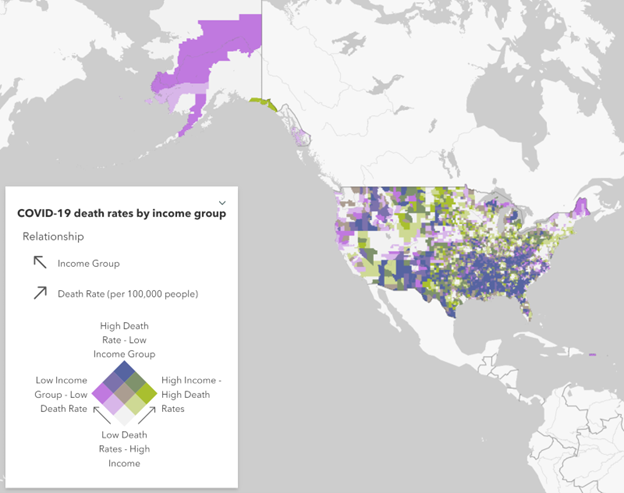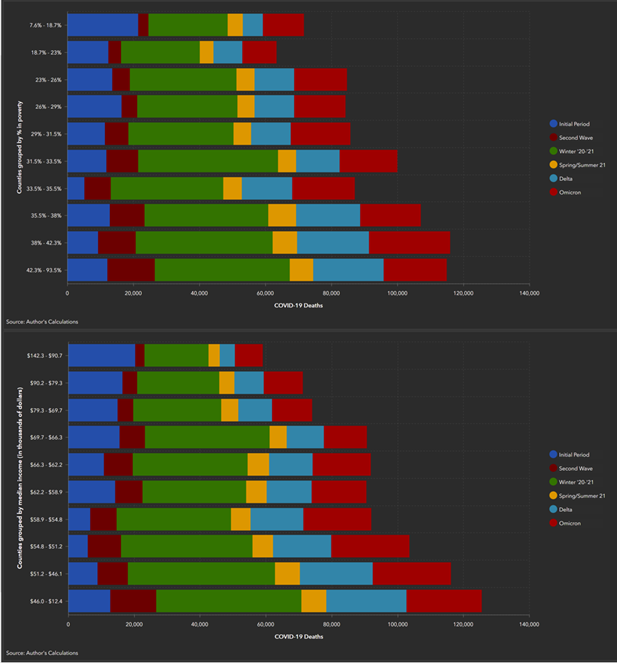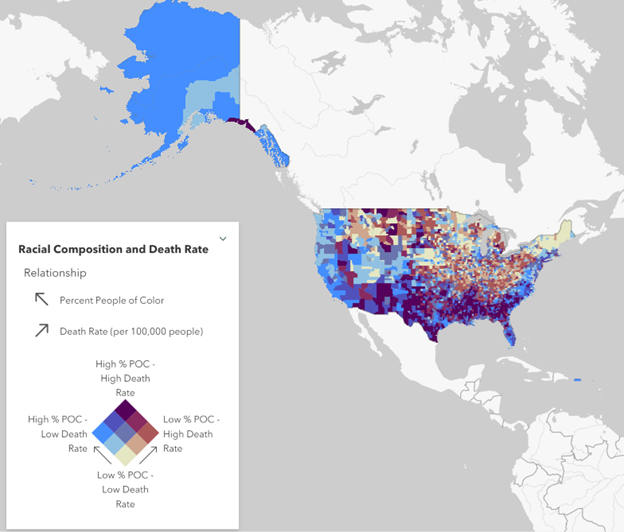Mapping the Intersection of Poverty, Race and COVID-19
The disproportionate impact of the COVID-19 pandemic on low-income and disadvantaged counties across the United States shows the need for advancing sustainable development across the country.
With the 17 Sustainable Development Goals, the 193 members of the United Nations agreed on ending poverty in all forms globally, ensuring healthy lives, and promoting well-being for all by 2030. These goals cover a wide swath of topics ranging from environmental protection to infrastructure, health, and poverty. This wide breadth was intentional and underscores how outcomes connect in overlapping ways. Lack of progress on one goal often hinders progress on others.
The COVID-19 Pandemic reinforced the link between poverty and health; lack of income frequently results in lack of access to health care. For countries around the world, this widespread virus represented an additional challenge to making progress toward these goals. As in many countries, the pandemic exacerbated preexisting social and economic disparities that have long festered in the US.
Concerned about the impact of poverty on COVID-19 deaths, a team of researchers from the United Nations Sustainable Solutions Network and the Poor’s People Campaign worked together to create and present A Poor People’s Pandemic Report: Mapping the Intersections of Poverty, Race and COVID-19.
This innovative study analyzed US data at the county level. It aggregated demographic data including income and race for all 3,200 counties, then connected this to information about COVID-19 deaths.
To overcome data limitations, we defined poverty as people living below 200% of the official poverty measure since current measures are outdated. According to the United States Office of Personnel Management, the poverty threshold in 2019 was $13,300 for a single-person household under the age of 65 and $25,926 for a two-adult, two-child household.
The map below shows that the counties with the highest concentrations of impoverishment have COVID-19 death rates 50% higher than counties with the lowest concentrations of people living in poverty.

We sorted counties by median household income and percent of residents below the poverty line, then assigned each county into one of ten groups with roughly equal populations. We found that during the “Third Wave”, or winter of 2020 into 2021, death rates were 4.5 times higher in the group of counties with the lowest median income compared to those in the group with the highest median income. Additionally, death rates were five times higher in these low-income counties during the Delta variant. Omicron has had a death rate nearly three times higher in counties with lower median incomes. We found similar results when comparing counties with the highest and lowest proportion of people living in poverty.

We also mapped the racial dimension of COVID-19 deaths and found that counties that have more than 13.4% Black residents had a significantly higher COVID-19 death rate than other counties. Collectively, the group of counties with larger Black communities experienced 32 more deaths per 100,000 than counties that were not predominantly Black.

By offering an initial analysis of the deadly community-level consequences of poverty, economic insecurity, and systemic racism, this report reveals the terrible underbelly of the pandemic. This study highlights that the pandemic disproportionately impacted communities with a higher percentage of people of color, more individuals living below the poverty line, and lower household income. It also fills a data gap since most government agencies do not systematically report income and wealth information associated with COVID death rates. The Poor People’s Pandemic Report underscores the multidimensional nature of the SDGs and how policymakers need to work on effective responses to national complexities. Studies like this help identify who bears disproportionate burdens from this long-lasting pandemic, and emphasize the long road ahead to an inclusive, healthy future.
The digital report and the interactive dashboard include all US states and Puerto Rico. It can be accessed on: https://www.poorpeoplescampaign.org/pandemic-report/
Laura Nóra
Laura is a graduate of UCSD GPS’s Master of Public Policy program, where she focused on the intersection of the climate crisis and health policy, as well as Program Design and Evaluation. She served as a Research Assistant in the production of the Poor People’s Pandemic Report.

